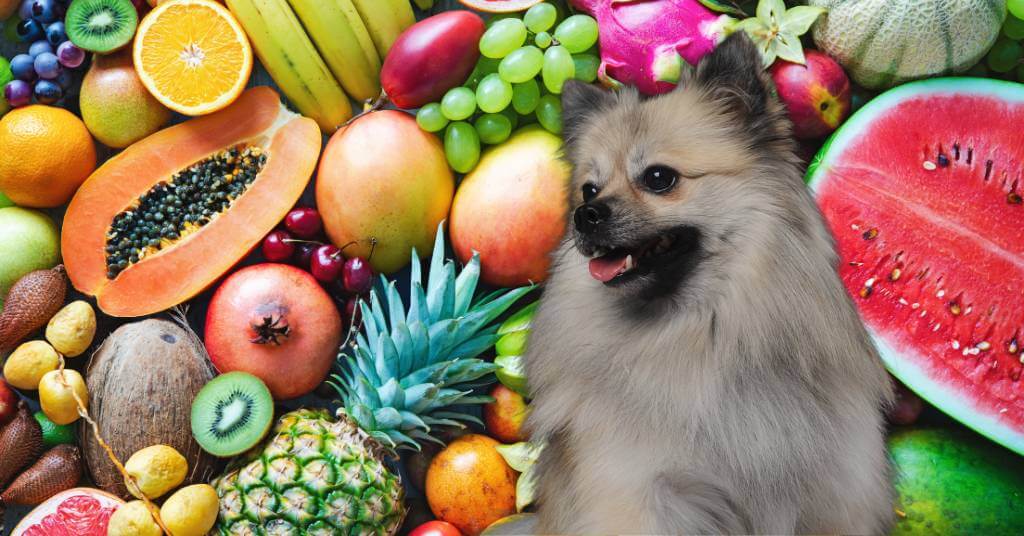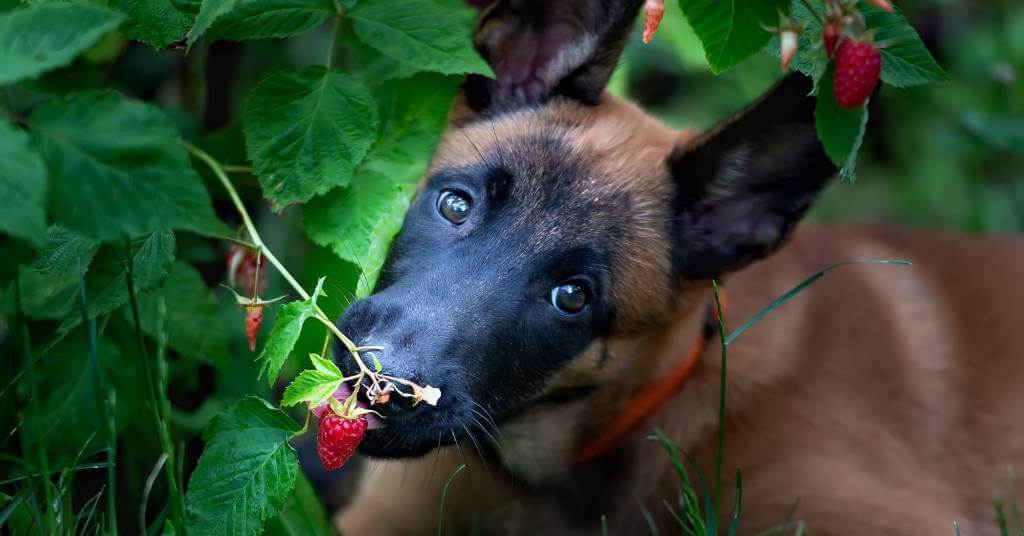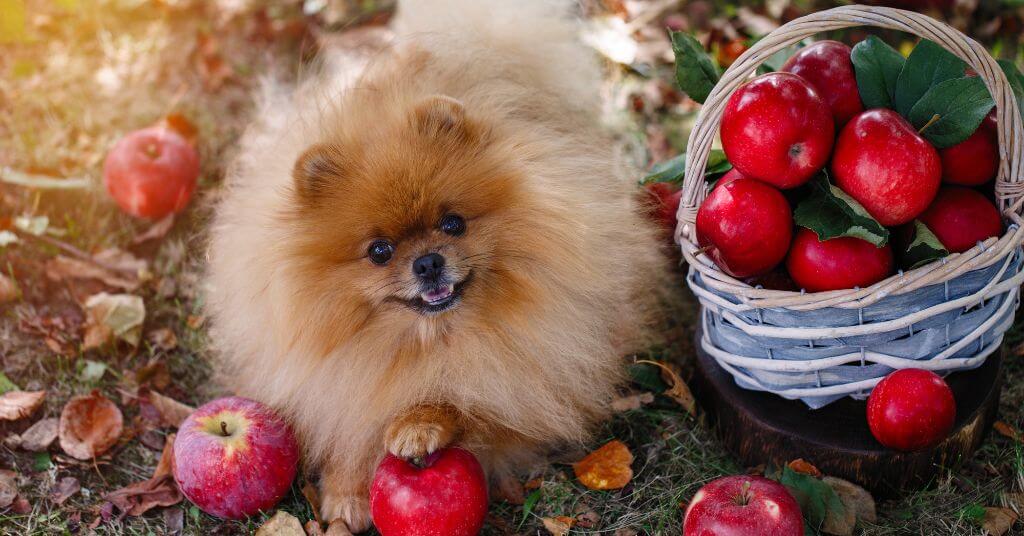17 Safe Low-Sugar Fruits for Dogs
This post shows you the benefits of 17 safe low-sugar fruits for dogs! It’s amazing just how much dogs love eating fruit! Even though they don’t need a lot of fruit in their diets (only 10% of a dog’s diet should be “extra” food), dogs can still enjoy fruit in moderation.

You need to learn about the fruits dogs can and can’t eat, as some are quite toxic to them! In addition, not all non-toxic fruits are considered healthy.
Healthy fruits for dogs should be low in calories, low in sugar, and high in vitamins and water!
That’s why in this article, I’ll show you the best low-sugar fruits for dogs and explain how to serve them and how much your dog can eat!

1 Avocado
Why they’re good for dogs: Avocado is super high in healthy fats! It’s great for dogs that need an extra boost of energy or dogs that don’t eat much! Avocado flesh also has nutrients that are good for your dog’s skin and coat.
How much to give: Since it’s high in fat, avocado is only recommended in moderation. A spoonful for larger dogs and a teaspoon for smaller dogs is just fine!
Health benefits: Avocado has vitamins A, E, and B6, which are great for the skin. In addition, it also has potassium, an important mineral for muscle health.
Warning: It’s a common myth that avocados are toxic to dogs. Only the pit, skin, and leaves contain persin, a toxin that’s dangerous to dogs. Avocado flesh still has persin in tiny amounts, but not enough to cause issues. Still, only give avocado to your dog in moderation!
2 Cherry Plums
Why they’re good for dogs: Cherry plums are a juicy, low-sugar fruit for dogs! They are super hydrating and can be quite refreshing on hot summer days. Naturally sweet, dogs love them, but they are actually low in sugar, making them a perfectly safe snack!
How much to give: Smaller dogs can have one small cherry plum, while larger dogs can have two or three. Be careful, as plums are rich in fiber, and eating too much isn’t good for dogs! Their sensitive digestive systems can’t handle too much fiber.
Health benefits: Plums are rich in antioxidants and vitamins! They’re also great for digestion, so if your dog ate a lot of hard, dry food, try giving them a cherry plum as a fruit snack. Fiber will help with digestion.
Warning: The pit is dangerous and a serious choking hazard. Never give your dog whole plums to eat. You have to remove the pit, and if you have a small dog, it’s best you cut them in half.
3 Blueberries
Why they’re good for dogs: Blueberries are a perfect low-sugar fruit that dogs love. They’re tasty, juicy, and full of antioxidants! There’s even a study about dogs eating blueberries that shows they help with muscle recovery in active dogs (they tested sled dogs!).
How much to give: Blueberries are very dog-friendly, and most dogs can eat a handful once or twice per week. Larger dogs can have more. Like all fruits, blueberries should not make up more than 10% of a dog’s diet. Everything else should be dog food.
Health benefits: Blueberries are rich in antioxidants, helping with muscle recovery, cell regeneration, and overall health. They also contain lots of vitamins and fiber that support the immune system.
Warning: Too many blueberries can cause runny poo and upset your dog’s stomach.
4 Strawberries
Why they’re good for dogs: The most popular low-sugar fruits for dogs are definitely strawberries! And for good reason! They’re soft, great for dental health, and easy to combine with other fruits like apples or foods like yogurt.
How much to give: A couple of strawberries make a great occasional treat or addition to their dog bowl. Larger dogs can have more, but monitor your dog to see how they affect digestion.
Health benefits: Strawberries are hydrating and packed with vitamins and minerals. They’re rich in fiber, particularly soluble fiber, which dissolves in water and helps regulate digestion.
Warning: Wash the strawberries and remove the tops before sharing them with your dog. Don’t give them too much fruit, as excessive amounts aren’t good for dogs.
5 Blackberries
Why they’re good for dogs: Blackberries are juicy, healthy, and rich in minerals and fiber! They’re on our list because they’re quite low in sugar.
How much to give: Similar to blueberries, small dogs can have a few, while larger dogs can have a handful each week. A popular treat is mixing frozen blackberries with cooked pumpkin to make a frozen summer snack for dogs!
Health benefits: Blackberries are rich in vitamins and fiber. They offer similar benefits to other berry fruits.
Warning: Don’t give your dog wild blackberries unless you’re 100% sure about identifying them. Avoid letting them eat blackberries straight from bushes, as they could be dirty.
[dog eating raspberries]
6 Raspberries

Why they’re good for dogs: Raspberries are rich in minerals and vitamins, making them a great treat for dogs that love fruit. They’re low in calories, which makes them perfect for snacking.
How much to give: Similar to other berries, one or two raspberries are enough for smaller dogs, while larger dogs can have a handful per serving.
Health benefits: Raspberries are refreshing, juicy, good for digestion, and high in fiber!
Warning: Too many raspberries can upset your dog’s stomach, so don’t overdo it. You’ll read online that raspberries contain xylitol and are dangerous for dogs, but that’s simply not true.
7 Pomelo
Why they’re good for dogs: A bit unusual but a healthy choice, pomelo is a low-sugar fruit for dogs that’s great to share on hot summer days because it’s full of water! Even though it’s a citrus fruit, it’s not acidic, so it won’t upset your dog’s stomach. Plus, it’s low in calories, making it perfect for snacking.
How much to give: Give your dog 1–2 small pomelo pieces as a treat. Larger dogs can have more, but pomelo is more of an occasional snack than a fruit bowl staple.
Health benefits: Pomelo has natural enzymes that can help with digestion, along with fiber that can aid constipation.
Warning: Don’t give dogs too much, as excess fiber isn’t good for them. Be sure to peel the pomelo and remove the white pith and seeds before serving.
8 Tangerines
Why they’re good for dogs: Tangerines are sweet, juicy, low in calories, and low in sugar. They’re hydrating citrus fruits that aren’t too acidic, so they won’t upset your dog’s stomach when given in moderation.
How much to give: Dogs can have 2–3 slices as an occasional treat. Larger dogs can have more, but it’s best to limit tangerines to a couple of slices.
Health benefits: Tangerines are hydrating, sweet, and a great source of vitamins.
Warning: Don’t give your dog whole tangerines to play with! You have to peel them and remove the seeds before you share them with your dog.
9 Pears
Why they’re good for dogs: Pears are amazing low-sugar fruits for dogs! They’re sweet, crunchy, hydrating, and very easy to share. Just wash, slice (remove the core and seeds), and enjoy sharing them with your dog!
How much to give: Small and medium dogs can have about half a large pear per serving, while larger dogs can eat a whole pear.
Health benefits: Pears are low in sugar and rich in vitamins, including vitamin K, which is great for the immune system and bone health.
Warning: Don’t give your dog whole pears! Always cut them into small pieces and remove the core and seeds.
10 Apples

Why they’re good for dogs: Apples are a staple of dogs’ diets! Paired with peanut butter, they’re a match made in heaven. Apples are crunchy, sweet, easy to serve, and perfect for dogs!
How much to give: Small dogs can have half an apple or a few slices, while large dogs can have more. If you’re mixing apples with peanut butter or yogurt, consider making it a meal rather than a snack to avoid overfeeding.
Health benefits: Apples are great for chewing and dental health, low in sugar, low in calories, and rich in vitamins.
Warning: Remove the seeds and core before sharing apples with your dog. While apple seeds contain cyanide, dogs usually swallow them whole, so they aren’t typically harmful. Still, it’s best to remove them.
11 Peaches
Why they’re good for dogs: Peaches are one of the best summer fruits for dogs. They’re low in sugar, juicy, sweet, and hydrating! Soft and easy to chew, they’re especially great for senior dogs.
How much to give: A few slices are enough for small dogs, while larger dogs can have more. Peaches go great with oatmeal or yogurt if you’re looking for meal prep ideas for your dog.
Health benefits: Peaches are hydrating, low in calories, and great for frozen treats. They also contain vitamin A, which is important for healthy skin.
Warning: Never give your dog a whole peach to eat, as the pit is a choking hazard.
12 Figs
Why they’re good for dogs: Figs are an unusual choice but very sweet, rich in natural sugar, and full of water and fiber to balance that sugar content. This makes them suitable as part of a low-sugar diet for dogs.
How much to give: One fig is enough for small dogs, while larger dogs can have a couple more as a treat. Avoid dried figs, as they can have a laxative effect.
Health benefits: Figs are great for digestion, as they’re high in fiber, and they also have lots of antioxidants and vitamins.
Warning: Don’t overfeed, as too many figs can upset your dog’s digestion.
13 Oranges
Why they’re good for dogs: Oranges are juicy, sweet, and safe for dogs, despite being citrus fruits. They’re not as acidic as other citrus options, so they won’t upset your dog’s stomach.
How much to give: Similar to tangerines, small dogs can have a few slices. Larger dogs can have more, but since oranges are still citrus fruits, stick to just a couple of slices.
Health benefits: Oranges are super healthy, hydrating, high in vitamin C, potassium, and antioxidants.
Warning: Remove the peel and seeds before feeding.
14 Watermelon

Why they’re good for dogs: Even though watermelon is considered to have a moderate amount of sugar, it’s still a low-sugar fruit for dogs because it’s 90% water! Most dogs adore watermelon, as it’s juicy, refreshing, and hydrating.
How much to give: A few small cubes for smaller dogs, while larger dogs can have more.
Health benefits: Watermelon is great for hydration and perfect for chubby dogs that need volume eating. It’s low in calories and supports weight management.
Warning: Remove the seeds and all the rind before sharing watermelon with your dog.
15 Cranberries
Why they’re good for dogs: Cranberries are easy to share and great for urinary health. While they are slightly higher in sugar, their tartness means dogs won’t eat too many, making them a safe option in moderation.
How much to give: A couple of cranberries is enough for most dogs. You can cut them into thin pieces and mix them with other fruits or yogurt.
Health benefits: Cranberries are often included in dog kibble because they promote kidney and urinary health.
Warning: Avoid sweetened dried cranberries, as they contain unnecessary added sugars.
16 Kiwi
Why it’s good for dogs: Kiwi is an amazing fruit. It’s slightly higher in sugar, which is why it’s further down the list, but it still qualifies as a low-sugar fruit for dogs. Kiwi is soft, which is why it’s great for senior dogs with dental problems.
How much to give: Half a kiwi for smaller dogs and a whole kiwi for larger dogs.
Health benefits: Kiwi contains lots of vitamins, water, and healthy fiber. Like blueberries, it’s also high in antioxidants, which are important for overall health.
Warning: Always pick ripe kiwis, as unripe ones are sour, hard to chew, and taste terrible. Also, always peel the kiwi before sharing it with your dog.
17 Lychee
Why they’re good for dogs: Lychee may be hard to find, peel, and remove the pit from, but it’s super tasty and refreshing! Its unique flavor makes it a fun treat for dogs.
How much to give: One or two lychees are enough.
Health benefits: Lychee is hydrating and low in calories.
Warning: Remove the hard, spiky peel and the pit before sharing lychee with your dog.
How to tell a fruit is low in sugar?
If you’re trying to figure out if a fruit is low in sugar, two terms can really help—Glycemic Index (GI) and Glycemic Load (GL). People who have diabetes, insulin resistance, or just monitor their sugar intake often use these to measure and track how fruit sugar affects blood sugar levels.
There are many websites and online calculators you can use, and I like this one.
Glycemic Index (GI): This is a scale from 0 to 100 that tells you how fast a food makes your blood sugar go up. Fruits with a lower GI (under 55) are digested more slowly, so they keep blood sugar steady instead of causing a big spike. Think of fruits like berries, apples, and pears—they’re great examples of low-GI options.
Glycemic Load (GL): While GI measures the speed of sugar release, GL takes portion size into account, making it a more practical measure. It’s calculated by multiplying the GI of a fruit by the amount of carbohydrates (in grams) in a typical serving and dividing by 100. A GL of 10 or below is considered low.
Understanding GI and GL can make picking low-sugar fruits a lot simpler. Smaller portions of higher-GI fruits might still be okay, while low-GI fruits are usually a safer bet.
| Fruit | Glycemic Index | Glycemic Load |
|---|---|---|
| Avocado | 10 | 0.9 |
| Cherry Plum | 25 | 0.0 |
| Blueberry | 25 | 2.0 |
| Strawberries (fresh berries) | 25 | 1.9 |
| Blackberries (fresh berries) | 25 | 2.5 |
| Raspberries (fresh berries) | 25 | 3.0 |
| Pomelo | 25 | 2.0 |
| Tangerines (fresh) | 30 | 3.9 |
| Pear | 30 | 4.7 |
| Apple | 36 | 5.0 |
| Peach | 35 | 4.0 |
| Fig (fresh) | 35 | 6.7 |
| Orange | 35 | 4.1 |
| Watermelon | 50 | 5.2 |
| Cranberries (fresh) | 45 | 5.5 |
| Kiwi | 50 | 7.3 |
| Lychee (fresh fruit) | 50 | 7.6 |
Which of these low-sugar fruits do you think your dog will love most? Let us know in the comments!
Don’t forget to pin this post so you’ll always have these fruits handy!
Love, life, and fur forever!

This post showed you 17 Safe Low-Sugar Fruits for Dogs.
You may also like: